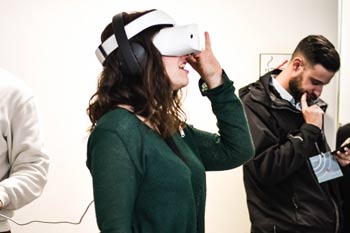If you’ve seen AR (Augmented Reality) in action on an app like Snapchat, then you can be forgiven for thinking it might be a little bit gimmicky. The fact is, though, augmented reality has a big part to play in ecommerce, and the technology is here now.

We all want to push our sales on to the next level, and AR is one of the tools that can really help you achieve this. With good use of AR, you can attract your perfect customers, increase the likelihood of them converting, and turn them into regular customers.
Online shopping might be convenient, but it still can’t offer the full experience of physical shopping where you can try things on and see them with your own eyes. However, AR is helping to bridge that gap and make online shopping even more appealing.
What is AR?

AR technology allows people to augment a live picture with 3D visuals in a seamless manner. As mentioned, we commonly see AR on Snapchat, where we can put our faces in the screen and add things like dog ears that sit on top of our heads and follow us around as we move.
This technology has many practical applications in ecommerce, though, as it allows people to see the products they want to buy in the environment they want to put them in. For example, if you wanted to buy a plant pot, you could get your phone out and open the camera, walk around your house and have an app seamlessly add the plant pot you want to buy.
Virtual Solutions
Ecommerce businesses are always looking for new ways to engage and convert customers. Augmented reality (AR) is one of the hottest trends in ecommerce right now, and businesses are using it in a variety of ways to create a more immersive and interactive shopping experience.
One of the most popular applications of AR in ecommerce is virtual try-on solutions. These allow shoppers to see how an item would look on them without having to physically try it on. This is especially helpful for items like clothing and accessories, where fit and style are important factors in the purchase decision.
Virtual try-on solutions are still in their early stages, but there are already a few different platforms and applications available. One of the most popular is ModiFace, which offers a suite of AR tools for beauty retailers, including virtual try-ons for makeup products.
Other businesses are using AR for product visualization. This allows shoppers to see what a product would look like in their home or office before they make a purchase. IKEA has been a pioneer in this area, with its IKEA Place app that lets shoppers see how furniture would look in their space.
Boost Conversion Rates
It takes a lot of hard work to get someone to the point where they’re looking at your product page and considering a purchase. You want to be taking advantage of every tool at your disposal to get those people to convert – AR is a particularly effective one.
Being able to see what you look like in a shirt, or see how a plant pot looks in your house isn’t just novel, it’s useful too. It’s small details that convince people to actually go through with a purchase, and knowing you look good in the shirt you’re about to buy is as good a reason as any.
Create Repeat Customers
AR isn’t just useful on your product pages, (although there are many great augmented reality apps for smartphones), but it’s also extremely effective for things like user manuals and building your brand.
Imagine if customers could put products together using an AR app that shows them exactly what to do in a “real world” experience. Not only would it mean you have fewer complaints that it’s hard to put together, but it’s going to say so much about your brand.
Embracing AR shows your customers that you’re willing to embrace the future in order to give them the best experience possible. For now, you can’t enable them to touch the product through the computer, but you can do the next best thing.
How Ecommerce Businesses Are Using Augmented Reality

Ecommerce businesses are using augmented reality to provide a more immersive experience for their customers. This technology is being used to create virtual showrooms, try on products, and view products in new ways. AR is also helping businesses to better understand customer behavior and preferences.
The Benefits of Augmented Reality for Ecommerce Businesses
The potential benefits of augmented reality (AR) for ecommerce businesses are huge. AR has the potential to completely change the way we shop online, making the experience more immersive and interactive. Here are just a few of the ways that AR could benefit ecommerce businesses:
1. Increased Engagement and Sales
With AR, customers can try before they buy, which could lead to increased sales for ecommerce businesses. Customers would be able to see how products look in their homes or on their bodies before making a purchase, which would give them a better idea of whether or not they actually want to buy the product.
2. Improved Customer Service
AR can also be used to improve customer service. For example, if a customer is having trouble assembling a piece of furniture they bought online, an AR tutorial could be provided to help them out. This would be much more effective than trying to explain things over the phone or through a text chat.
3. More Accurate Inventory Management
AR can also help ecommerce businesses with inventory management. By overlaying product information on top of real-world objects, businesses would be able to track inventory levels more accurately and quickly identify when items need to be restocked
Preview Placement
As ecommerce businesses continue to grow and evolve, so too must their marketing and sales strategies. One of the most exciting and innovative new technologies being used by ecommerce businesses is augmented reality (AR).
AR allows businesses to provide their customers with a more immersive and interactive shopping experience. By superimposing digital content onto the real world, businesses can give their customers a better idea of what their products look like and how they can be used. This can be particularly helpful for products that are difficult to visualize, such as furniture or home décor.
AR is still in its early stages, but there are already a number of ecommerce businesses that are using it to great effect. IKEA, for example, has developed an app that allows users to see how furniture would look in their homes before they purchase it. Wayfair has also launched a similar app, which includes a feature that lets users view 3D renderings of furniture in their homes.
There are endless possibilities for how AR can be used by ecommerce businesses. As the technology continues to develop, we can expect to see even more businesses using AR to give their customers a better shopping experience.
Interactive User Manuals
There's no doubt that ecommerce businesses are always looking for new and innovative ways to engage their customers and increase sales. And one of the latest trends to emerge in this arena is the use of augmented reality (AR) for interactive user manuals.
With AR, businesses can provide an immersive and interactive experience for their customers that can help them better understand how to use a product. This, in turn, can lead to increased sales and customer satisfaction.
There are a number of different ways that businesses are using AR for interactive user manuals. One popular method is to create an AR experience that can be accessed through a smartphone or tablet. This allows businesses to take advantage of the built-in camera and sensors in these devices to create an interactive experience.
Another way businesses are using AR is by integrating it into their existing website or online store. This approach allows customers to view an AR experience right on the website or online store without having to download any additional apps or software.
So far, the response from customers has been very positive and many businesses are seeing increased sales and satisfaction as a result of using AR for their interactive user manuals.
Supercharge Your AWeber Account
Take Your Email Marketing To The Next Level With These Powerful Tools
How Augmented Reality Is Being Used in Ecommerce
Augmented reality is still in its early stages, but there are already a number of ecommerce businesses that are using it to offer innovative and immersive shopping experiences for their customers. Here are just a few examples:
Ikea has created an app that allows shoppers to see how furniture would look in their homes before they buy it.
Tommy Hilfiger has launched an AR app that lets users see what clothes look like on a virtual model before they purchase them.
Makeup giant Sephora has developed an app that lets users “try on” makeup before they buy it.
These are just a few of the ways that augmented reality is being used in ecommerce. As the technology continues to develop, we can expect to see even more businesses finding innovative ways to use AR to enhance the shopping experience for their customers.
Augmented Reality Can Help Grow Your Store
AR is not just for gaming and entertainment anymore. AR is being used in a variety of industries, including ecommerce.
There are a number of ways that AR can be used to enhance the online shopping experience. For example, you can use AR to try on makeup or clothing before you buy it. AR can also be used to give customers a better idea of what a piece of furniture would look like in their homes. And it can be used to provide interactive product demonstrations.
But how can AR help you grow your ecommerce business? Here are three ways:
- Increase conversions by allowing customers to try before they buy.
- Enhance the customer experience and create loyalty by giving them a more immersive shopping experience.
- Generate buzz and interest in your products by doing something unique and different that will get people talking.
If you're looking for a way to take your ecommerce business to the next level, augmented reality is definitely worth exploring.
The Future of Augmented Reality in Ecommerce
Ecommerce businesses are always looking for new ways to engage and immerse their customers in the shopping experience. And with the rise of augmented reality (AR), they now have a powerful tool at their disposal to do just that.
AR allows businesses to superimpose digital content onto the real world, giving shoppers a new way to interact with products. For example, IKEA has been using AR for a few years now to allow customers to “try out” furniture in their homes before making a purchase.
Other businesses are using AR to create interactive displays in their stores. Sephora, for instance, has an AR beauty try-on experience that lets shoppers “try on” makeup virtually before buying it.
There are endless possibilities for how ecommerce businesses can use AR to enhance the shopping experience. And as the technology continues to evolve, we can only imagine even more innovative and immersive ways that businesses will put it to use.
What Do You Advocate?
